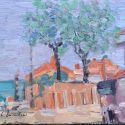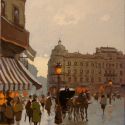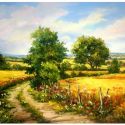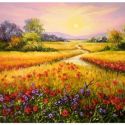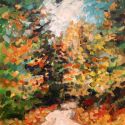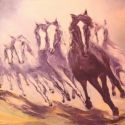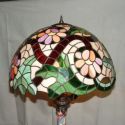Pablo Picasso (25 October 1881 - 08 April 1973), Spanish painter.
Pablo Picasso, by his full name Pablo Diego Jose Francisco de Paula Juan Nepomuceno María de los Remedios Cipriano de la Santisima Trinidad Ruiz Picasso, was one of the greatest and most influential artists of the 20th century, a master of painting who changed forever the artistic landscape.
Born in Malaga, Spain, he was the son of Jose Ruiz Blasco, a professor of drawing, who encouraged his son to draw and hoped that Pablo would later follow a career in academic art. A strong and mature talent, Picasso had his first exhibition at the age of 13. Later he decided to abandon his art studies and dedicate himself to experimenting with modern styles and techniques.
In 1900 Picasso left for Paris and an year later had his first Parisian exhibition at a gallery on rue Lafitte. He was still unknown to the French art world (and also to his homecountry) but was already a prolific artist, having produced already several hundred drawings. Having atracted several favorable reviews, he would later return to Paris, where he settled for good. He worked for more than 80 of his 91 years of life, and produced a frightening amount of works, over 50.000 paintings, drawings, sketches, engravings, sculptures, ceramics. His artistic creation can be separated into several distinct periods.
The first important period of his career began after his first Parisian exhibition, and would be later known as the "blue period", for Picasso used various shades and tones of this color to evoke the melancholic world of the poor.
Then followed the "rose period", during which he often painted circus scenes and began experimenting with sculptures. His first shocking creation was "Les Demoiselles d'Avignon", made in 1907, which surprised the critics by its fragmented and distorted representation of the human form, marking a decisive brake from European artistic tradition. By then Picasso was strongly influenced both by the works of Paul Cezanne and the African art, and his compositions anounced the Cubist movement.
This mouvement was founded by Picasso and Georges Braque in 1909. In Cubism - which is divided in two distinct phases, analytical and synthetic - Picasso and Braque started with the modern principle that an artwork does not need to represent reality to have artistic value. Most of the works produced by Picasso during this timeframe, including his costumes and sets for Ballets Russes (1917) were daring experiments. Together with Braque, Picasso invented several new techniques, one of them being the collage.
After his Cubish phase, Picasso began exploring classical themes, but violent images, marked by anguish, became more and more frequent. This new tendency came to completion in 1937, with his masterpiece Guernica, an ample and detailed worked that evoked the horror of the destruction of the Basque Town by the German airforce, in the Spanish Civil War. During the Second World War Picasso remained in Paris, even during the Nazi occupation, although he was a stern opponent of fascism. He hated the Nazis so much that after the war he did not hesitate to become a member of the French Communist Party, a choice that would later bring him a lot of critics.
Even if his afterwar period is less known and studied, Picasso continued to work in the same manner, producing thousands of different works and enjoying critical and commercial success. Most of this later compositions were fantastical or variations on the famous works in the history of painting.



